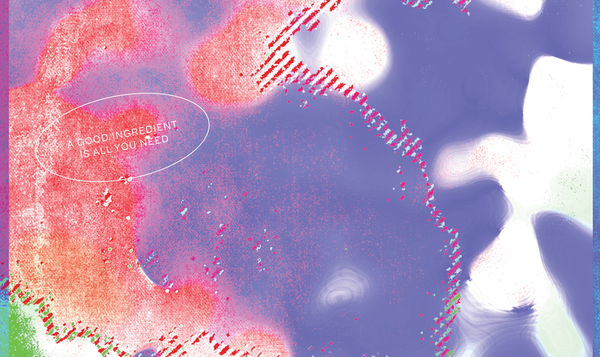May 2024 Subscription - On Taste

Crickets are the backing track to our zippy inhales through the door, cracked to the street. A motorbike zooms by while dogs start a muffled song from across the block. Each last zip in the room is a gasp, as if aspirating will liberate the whole story cradled in the spoon. The last of us step away from the cupping table in a small concrete room in Pitalito. Collectively, we stare down at our respective notes - some with phone in hand, notes app open. I have a mini moleskine journal, spine supple from being cracked open on most of the pages. This one green, a rainbow of the filled ones stacked in a shoebox back home. One for each year I've been cupping coffees for a living.
Debriefing a cupping is a dance of diplomacy and vulnerability. Are you tasting what I'm tasting? Are the coffees I loved the most on this table available in the lot size that would work for the volume of coffee I need? Would we be able to put together enough coffees in time for a consolidated shipping container to leave asap? How were these coffees dried? Are they going to last through the journey to us and cup in the exact same way we first encountered them today?
For the last question, invariably the answer is no.
I love coffee for very same reasons folks get frustrated with it. How a coffee tastes in one framework will shift and settle like a house on sand - Each time it sits just a bit differently. There are enough Reddit threads and YouTube channels on the subject to know that despite this truth, it's in our nature to try and hold a thing we adore so still, it dies. We want to freeze it in place, to press rewind and enjoy the same stunningly extracted cup we nailed, and 'holy shit this thing really does taste like schnoz-berries!'. We want to be able to replicate it for a loved one or friend or even just ourselves. Sometimes we succeed.
The lab manager goes first, "mora, melon, chocolate, largo final". I go next, honing in on the bracing acidity of this cup. All the while I'm thinking of mora, blackberries, and how many different interpretations there can be for a single tasting note or in this case, a single, unassuming forest berry. A blackberry picked in Central or South America is likely going to be a different iteration to one picked on a day in Pacific coastal Canada mid August when the sun leans down on you, your skin salty with sweat, squeezing plump thin skinned purple orbs between your fingers as if testing the odds. The first you pop in your mouth and a violet purple jolly rancher almost artificial sweetness floods. The second berry you take is more like lemon juice. From one berry to the next, even on the same vine, there's clear differences. A thorny wheel-of-fortune.
Tasting notes = facts?
When we (that's 'industry' we) talk tasting notes on bags, what's our goal? Are we dictating what you're going to taste, some sort of feudal overlord of mouths?
The competition circuit has evidently taken this tack, with scores that go ever higher the more accurate you are with your 'flavour calls'. An easy rebuttal here is to say that's not what's happening - The competitor is simply making a promise and has to deliver on it. That the competitor has taken so much time with the coffee that they know with exacting green storage, roasting and brewing so they can stick the landing in the judges minds. If coffee is a game of chance, our job as industry folk is to make the odds more favourable.
Some coffee roasters have gone the route of throwing the whole concept out, foregoing tasting notes entirely.
That doesn't seem like the right approach either. The door of connection slams shut - A confusing choice for what is undeniably a social drink. Maybe in doing this, it somehow absolves themselves of something. But is there anything they need to be absolved of if they're simply sharing what they were tasting?
What's that smell?
Tasting and smelling stuff has been a relative black box, in large part due to how the scientific process works relative to how our complex internal systems work - But the topic's esotericism hasn't stopped people from trying to figure out how to study (and even outsource) the most feral, ancient activity we do. In Aeon's How to Make a Map of Smell The author (Jason Castro associate professor of neuroscience at Bates College in Maine, US.) takes us through a play by play of some of the different ways researchers have attempted to uncover how we experience smell. From Henning's simplistic and inherently flawed 'smell prism', to Susan Schiffman's more cartographical approach in the 1970s, there hadn't yet been a breakthrough for how our noses get to the answer of "rose" or "blackberry", or why things smell like other things (coffee with heady florals for instance). Flavour wheels and smelling prisms sound tidy, buttoned up, contained. In doing so, it ignores the reality that we are not living tuning forks or refractometers (though we really try to be - As a lapsed Q grader I can speak to the pursuit). Smell's function is far less contained than that. It's a sprawling mess of relational stuff - less colour wheel, more raggedy forest.
The Osmo Model brings us way closer to understanding the underpinnings of olfaction. A million parameter 'deep net' digital program tasked with reverse engineering the entire process of smell. This model, equipped with data points to the atomic level, is tasked with "here's decayed leaf, figure out how we get there". This allows us to explore a slightly different question - What happens in the liminal space between the experience of a smell, and the naming of it?
Jason Castro writes the following on the smell-o-sphere:
Odour space, in other words, is framed in human-centred coordinates, reflecting our histories as foragers and hunters in a world that blooms and withers, with matter that ripens and decays. It is a geometry that invests matter with its meanings and possibilities for us.
But it’s not just some loosely poetic space. Tapping the Osmo model, one can compute distances and angles here, predict which chemical will smell exactly halfway in-between musk and carvone, examine whether a collection of chemicals should trace out a smooth or squiggly path in odour-perceptual space.
With all of this, it's important to hold in your mind that, crucially, a map of experience is not experience itself (or, deep digital model Osmo isn't us).
So this is where we come in. Our role is to do the experiencing. Smells are scenes after all, symphonies, and noses aren't tuning forks, but rather instruments to interpret the smell realm-- feelers of vibes-- Something an AI model won't be able to fully capture (though no doubt we'll keep trying).
Tasting notes = vulnerable, social offerings.
"Podemos hablar del sabor a mora por un momento"? I ask, when the last of us recited what we tasted. I wanted to know if we were tasting the same thing with that blackberry note.
We went on to discuss how the 'mora' in this person's mind was one that was blended into a drink from frozen with sugar (though she didn't like nearly as much sugar as what's normally put in), with the zippy acidity taking centre stage. This jived well with my interpretation of the coffee in question, with my zoning in on how bracingly crisp this coffee was. If me and my cupping companion here were both blindfolded, given a drink, told "ok this is blackberry" and we went to taste - Would one of us be surprised? Maybe. Having this clarifying conversation brought some nuance, and we both realized we were talking about the same thing, just in ways that we were uniquely familiar with.
Our individualistic western society has taught us that our experiences aren't to be trusted and the result is we constantly go outside ourselves to find the answer. We're trained to think there is a singular correct answer (the tasting note on a bag of coffee perhaps?) and if there's a disconnect then some party is to blame (the brewer? the roaster? the producer?). Under these conditions, its no longer a game of chance - It's zero sum. It assumes that a coffee, or a person tasting a coffee, are static dead things. Unchanging. But in coffees case, and certainly for you and me, if you're tasting coffee, you're alive (congrats!) and that means you'll likely find you contain this multidimensional sensory map within yourself as you brew through any given bag of coffee. You'll change. You'll eat something different that day. You'll be in an excellent mood (sending you the best of vibes for this to be true). The coffee will also change.
In choosing the two coffees for this month's sub, this lot of Pink Bourbon from Nestor Lasso was an easy pick, the Pre-shipment coffee sample tasting overtly tropical with yellow fruits. On arrival and dial in, as luck would have it, heady florals came front and centre, as did the sensorial reminder that this coffee has undeniable Ethiopian landrace recent ancestry. It was a fun surprise. Being flexible in coffee is a prerequisite since ultimately no one can be in full control. We're in coffee for the same reasons that madden us - It shifts, shows a different side, and through it all, we get to connect over it and share it with you.
Your tastebuds/noses and how they're wired are yours and yours alone - Under the hood of our conclusions about the smell and taste of something include unique cultural experiences, memories, environments. This makes sharing what you're tasting a vulnerable act, not a scoreboard to compare your 'tasting ability' against. I think navigating coffee under that pre-tense is way less stressful and no less supportive of innovation and excellence (The World Brewer's Cup Champion just won using a different lot from Nestor as I write this!).
Between Nestor's beautifully clean take on Pink Bourbon, and a spiced comforting Red Bourbon from northern Peru's Merci Fernandez, we've got two lovely washed lots for May. Hope you enjoy both!
Luna is powered by Laura & Nate, two industry nerds from Vancouver, Canada. What you just read comes as a printed colour zine each month, alongside two coffees specifically sourced for subscribers. Join us next time!





